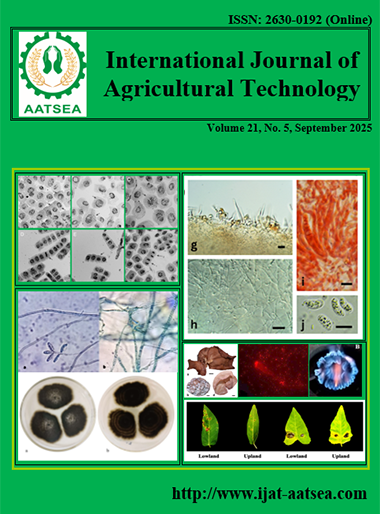Assessment of quality and safety at critical control points of cow's milk produced in Northern Mindanao
Main Article Content
Abstract
Results showed that 60% of raw milk samples tested positive in Alcohol Precipitation Test, but confirmatory tests with Clot on Boiling proved the samples otherwise. Methylene Blue Reduction Test at the different critical control points rated very good implying their acceptability for processing. Physico-chemical tests indicated butterfat at 4.58%, Solid Non-Fat at 8.92%, protein at 3.52%, Lactose at 4.72%, and Brix at 9.2%. Organoleptic quality tests showed acceptable appearance, color, and sedimentation. However, microbial culture shows E. coli and Total Coliform Counts are present beyond the acceptable limits in processed flavored milk, but none in plain pasteurized milk. The fat, SNF, and lactose contents were beyond minimum standards, while the protein was a little below the acceptable limits. These results may be attributed to the farms’ compliance with the Risk Management Plan for milking required by the National Dairy Authority that ensured the production of safe and quality milk. Regular monitoring and evaluation with further tests for farm hygiene and sanitation with bacterial tests may be done in the future.
Article Details

This work is licensed under a Creative Commons Attribution-NonCommercial-NoDerivatives 4.0 International License.
References
Atasever, S. (2012). Estimation of correlation between somatic cell count and coagulation score of bovine milk. International Journal of Agriculture and Biology, 14:315-317.
Becker, C. (2024). The value of water. Pennsylvania State University. Retrieved from https://extension.psu.edu/the-value-of-water
Butler, A., Nielsen, J., Slots, T., Seal, C., Eyre, M., Sanderson, R. and Leifert. C. (2008). Fatty acid and fat-soluble antioxidant concentrations in milk from high- and low-input conventional and organic systems: seasonal variation. Journal of the Science of Food and Agriculture, 88.
Cardot, V., Le Roux, Y. and Jurjanz, S. (2008). Drinking behaviour of lactating dairy cows and prediction of their water intake. Journal of Dairy Science. Vol. 91 Issue 6 pages 2257-2264.
Deka, R. P., Das, N. K., Sharma, P. K., Bayan, B., Gogoi, A., Lindahl, J. F. and Grace, D. (2020). Standard laboratory protocol on testing milk samples for quality and safety.
Department of Agriculture – National Dairy Authority (2019). Administrative Circular No. 04. Dairy Safety Regulations – Risk Management Plan retrieved from https://www.da.gov.ph/wp-content/uploads/2021/05/ac04_s2019.pdf
Food and Agriculture Organization and International Dairy Federation (2011). Guide to good dairy farming practice. Animal Production and Health Guidelines. No. 8. Rome.
Garedew, L., Berhanu, A., Mengesha, D. and Tsegay, G. (2012). Identification of gram-negative bacteria from critical control points of raw and pasteurized cow milk consumed at Gondar town and its suburbs, Ethiopia. BMC public health, 12:1-7.
Jaakamo, M. J., Luukkonen, T. J., Kairenius, P. K., Bayat, A. R., Ahvenj, S. A., Tupasela, T. M., Vilkki, J. H., Shingfield, K. J. and Leskinen, H. M. (2019). The effect of dietary forage to concentrate ratio and forage type on milk fatty acid composition and milk fat globule size of lactating cows. Journal of Dairy Science, 102:8825-8838.
Mennane, Z., Ouhssine, M., Khedid, K. and Elyachioui, M. (2007). Hygienic quality of raw cow’s milk feeding from domestic waste in two regions in Morocco. International Journal of Agriculture and Biology, 9:46-48.
Paraffin, A. S., Zindove, T. J. and Chimonyo, M. (2018). Perceptions of Factors Affecting Milk Quality and Safety among Large and Small-Scale Dairy Farmers in Zimbabwe. Journal of Food Quality, 2018:1-7.
Parker, D. and Brown, M. (2003). Water Consumption for Livestock and Poultry Production. Encyclopedia of Water Science. Retrieved at: https://www.researchgate.net/publication/
Pinto da Rosa, P., Pio Ávila, B.; Damé Veber Angelo, I., Moreira da Silva, P., Garavaglia, C. R., Nessy Mota, G., Aristimunho Sedrez, P., Albandes Fernandes, T., Bugoni, M. and Fernando Buttow Roll, V. (2020). Factors that affect the thermal stability of bovine milk and the use of alcohol test in the milk industry – a review. Nucleus Animalium, ISSN-e 2175-1463, Vol. 12, Nº. 2, pages 15-46 Retrieved from https://dialnet.unirioja.es
Schroder, D., Maichin, A., Lema, B. and Laffa, J. (2013). Microbiological quality of milk in Tanzania: from Maasai stable to African consumer table. Journal of Food Protection, 76:1908-1915.
Silva, S. D. S., Kanugala, K. A. N. P. and Weerakkody, N. S. (2016). Microbiological Quality of Raw Milk and Effect on Quality by Implementing Good Management Practices. Procedia Food Science, 6:92-96.
Sun, L. Y. and Hou, X. (2016). Effects of glucose on lactose synthesis in mammary epithelial cells from dairy cow. BMC Veterinary Research. Retrieved at https://doi.org/10.1186/s12917-016-0704-x
Tollossa W., Negera, E., Nurfeta, A. and Welearegay, H. (2014). Milk handling practices and its challenges in Borana Pastoral Community, Ethiopia. African Journal of Agricultural Research, 9:1192-1199.
Washaya, S., Jakata, C., Tagwira, M. and Mupofu, T. (2022). Bacterial milk quality along the value chain in smallholder dairy production. The Scientific World Journal, 7967569, 6 pages. https://doi.org/10.1155/2022/7967569


